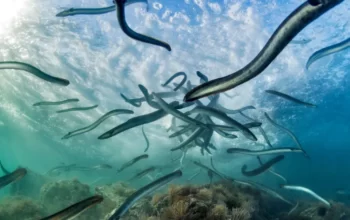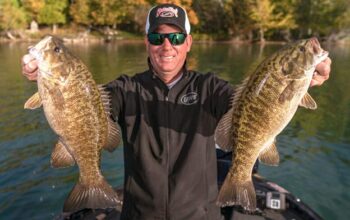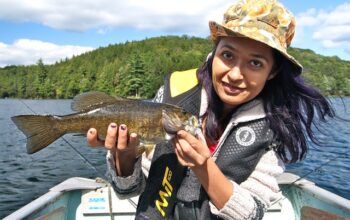Ceviche is an utterly delicious Finely cut raw fish marinated in citrus juice and served in Latin American cuisine, frequently with additional herbs and fresh ingredients like tomatoes, onions, and even seafood like octopus, scallops, or shrimp. The citrus acid in the dish cures the raw fish, rendering it safe to eat without the use of heat.
Red snapper, sea bass, halibut, fluke, flounder, mahi-mahi, snapper, sea bass, and tuna of sashimi quality are among the best types of fish for ceviche.
If you’ve ever noticed that your ceviche appears opaque and questioned whether it was actually cooked, know that acid, not heat, was responsible (source: Craftsy). The best place to start with your ceviche is with your fish, as with most recipes with few ingredients, the quality of each ingredient will play a significant role in determining the outcome.
Table of Contents
Origins of Ceviche
The need to preserve food led to the development of the fish preparation known as ceviche, which is fundamental to coastal South American cuisine. While the Incan Empire preserved fish in fruit juices, salt, and chili peppers, and introduced limes from Spanish conquerors, it is unclear where the dish originated. Citrus juices were later introduced when limes were introduced. Even the Polynesian Islands in the South Pacific are mentioned as possible origins in some sources. Regardless of its precise origin, Peruvian kitchens and eateries provide the most varied and plentiful examples of this dish. Even ceviche has been designated as Peru’s national dish.
There are different versions of the dish throughout South and Central America. Ceviche from Mexico or the related Aguachile (shrimp drizzled with a chili-infused lime mixture just before serving) from the northern Pacific coast of Mexico are served with crispy tostadas or tortilla crisps. Ceviche from Ecuador incorporates shrimp and tomato sauce into the marinade. Coconut milk adds a creamy element to Caribbean fashions. Even within Peru, a Japanese-Peruvian variation known as Nikkei adds another layer of variety with finely cut fish surrounded by soy sauce, togarashi, and sesame oil. In the 1980s, when Florida began importing Caribbean flavors, the dish first appeared on American menus.
Best Fish and Ceviche Ingredients
Any ceviche must have raw fish, citrus juices, and seasonings as its primary ingredients. The raw fish is the first and most crucial topic to cover. Purchasing fresh fish from a fishmonger or fish counter you trust is the best way to ensure the flavor and freshness of your dish. Inform them you’re making ceviche so they can share insight on the best catch for the day, but still use your discretion when choosing fresh fish. Fresh fish feels firm to the touch and has a briny, not fishy, odor. And always buy your seafood on the same day that you intend to make ceviche.
Fish with a texture that allows the flavors to be absorbed more readily is best for ceviche: white, firm, flaky. Red snapper, sea bass, halibut, fluke, flounder, mahi-mahi, snapper, sea bass, and tuna of sashimi quality are among the best fish for ceviche. There are some variations that also include shrimp, scallops, squid, or octopus. Regarding shrimp or other shellfish, please keep in mind that in order to ensure food safety, shellfish must always be blanched (cooked in salted boiling water until opaque, then quickly plunged into ice water to cool).
The toppings for ceviche add crucial texture and flavor components that harmonize the dish. Corn, cooked sweet potato, and fresh green herbs like cilantro and basil are all included in the Peruvian variations, which go well with the dish’s light flavors. Mango, papaya, or pineapples can add tropical sweetness; habaneros and bell peppers can add crunch; and avocados can add creaminess (bonus: the acid in the dish prevents the avocados from turning brown). Other favorites for giving ceviche a little crunch are popcorn or toasted corn kernels.
Read about Best Time of Day to Fish: How to Find the Best Time for Fishing?
How and Where to Buy Fish for Ceviche?
To obtain the ingredients for your ceviche, it is worthwhile to develop a friendship with your neighborhood fishmonger. Ask for the freshest saltwater white fish they have available. Choose the options with translucent flesh that are firm to the touch if they offer a few different choices. For added assurance that the fish is truly fresh, you can even give them a sniff. Southern Living says a fresh fish will smell briny, like the sea, rather than “fishy.” Never choose letter accuracy over freshness if your recipe calls for one white fish but another that day looks much better. Making a few extra shopping trips can make a big difference in a dish where the fresh flavors dominate.
Once you’ve chosen your fish, you’ll want to keep it as fresh as you can until you’re ready to cook. Until you’re ready to make your ceviche, Bon Appétit suggests wrapping the fish in plastic, placing it in a bowl of ice, with ice both below and on top of the fish. The freshness you worked so hard to obtain will be preserved in this way, and the ceviche will be much better as a result. If at all possible, Southern Living advises purchasing your seafood on the same day that you intend to make ceviche.
![What Are the Best Types of Fish for Ceviche [All Explained]](https://www.bearsfishing.com/wp-content/uploads/2022/11/What-Are-the-Best-Types-of-Fish-for-Ceviche-All-Explained-2.jpg)
How to Make Ceviche?
The fundamental procedures for making ceviche don’t change regardless of recipe variations. Fish should be diced and marinated in citrus juices in the refrigerator. To make dicing even easier, wrap the fish in plastic wrap and place it in the refrigerator before you start. This will maintain the fish’s flavor and texture. Additionally, to prevent harming the delicate seafood, use a long, sharp knife.
Timing is everything when marinating the seafood (completely covered, as air exposure can result in an inconsistent texture). Too short can mean too raw, but longer doesn’t mean better—the longer the fish “cooks,” you risk gummy, over-cooked seafood. After 10 to 15 minutes, the protein usually becomes more rigid. Between 15 and 25 minutes, it hits “medium,” and after 25, it becomes “medium-well.” Keep an eye on the fish and marinate it until it’s the desired degree of rawness, then top with ingredients and serve at room temperature or chilled.
Explore the Bounty of the Sea
Once you’re comfortable making ceviche, you might want to branch out and try one of the many variations that use unusual seafood and flavorings.
This Mexican ceviche from My Latina Table is something you should try if you like shrimp. With a healthy dose of hot sauce and fresh jalapeños, it is flavorful and spicy, and chunks of rich, creamy avocado help to balance it out.
Scallops are yet another excellent shellfish for ceviche. In this adaptation of a recipe from Martin Morales’ book “Ceviche: Peruvian Kitchen,” the tender flesh of the bivalve is dressed with lime juice, dotted with crunchy, tart pomegranate seeds, and drizzled with Pisco, the most well-known alcoholic beverage from Peru.
No matter which recipe, or recipes, you decide to try, there is one ceviche-related food item that you must not miss. Leche de Tigre, which translates to “tiger’s milk,” is the piquant juice left over after ceviche has marinated. According to Food & Wine, it is frequently consumed as a beverage, either alone or with ceviche as a prized hangover remedy.

![What Are the Best Types of Fish for Ceviche? [All Explained]](https://www.bearsfishing.com/wp-content/uploads/2022/11/What-Are-the-Best-Types-of-Fish-for-Ceviche-All-Explained.jpg)


